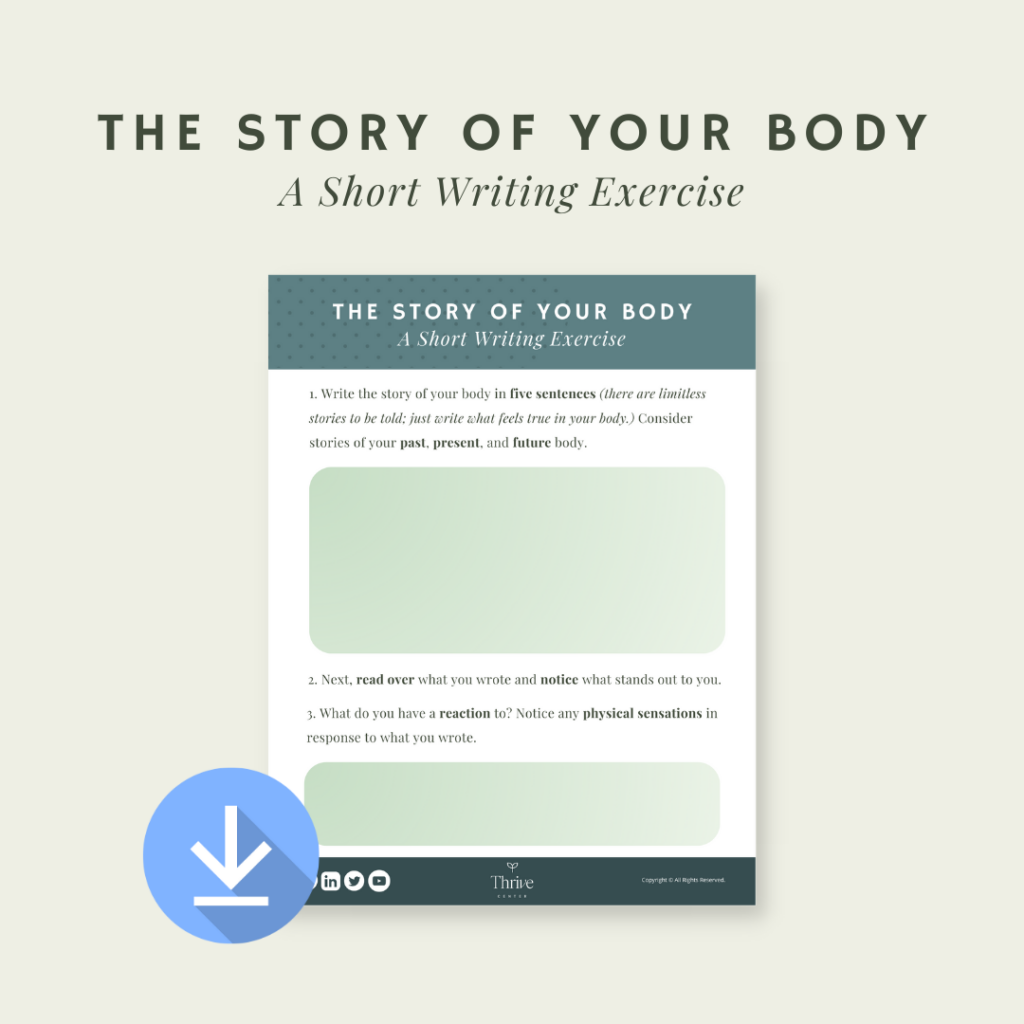“If you’re willing to pay attention to and dialogue with what’s happening inside of you, you’ll find that your body already knows the answers about how to live a full, present, connected, and healthy life.” – Dr. Hillary L. McBride
Recently, I sat on the beach in Santa Monica on a chilly evening with hopes of catching the sunset over the Pacific. Going to the beach for sunset periodically has become a self-care practice for me. It is a way for me to practice mindfulness, be present in my body, and even jump in the cold ocean waves to help me reset and feel grounded again after a long week. This particular evening, however, the sky was covered with dense clouds, and I’d be lying if I said I wasn’t feeling disappointed with the weather.
While I stared at the waves with the drab gray sky in the background, I suddenly witnessed a pod of dolphins swimming extremely close to the shore. While I have occasionally seen a dolphin or two in the distance, this time was different. For about an hour, I watched countless dolphins jumping and diving in the water. Something about their full-bodied enjoyment of the moment struck me – they looked playful, present, curious. Some jumped really high and made me wonder if they were having some sort of competition. Not only did my mood shift, but I noticed my body felt lighter. I felt quite joyful, almost giddy like a child, and laughed at the scene unfolding.
I am no expert on dolphin behavior by any means, but I am a researcher, and after that experience I learned that dolphins jump for many different reasons – to communicate with other dolphins, to play, to navigate, to identify their location by viewing the coastline, to warn of danger, to clean off other organisms that attach to their bodies, and to breathe. They are known to be a social species and demonstrate highly empathic, cooperative, and altruistic behavior.
While dolphins are also known to communicate with clicks, chirps, whistles, and echolocation, I was amazed by the way that they also communicate through this full-bodied gesture of jumping in and out of the water.
I’ve been reflecting on the way that we as humans communicate non-verbally and pick up on cues from observing the body postures of others. We read facial expressions to varying degrees of accuracy, and identify nuances in body language that may indicate how others are feeling.
In spite of our skills at reading others, we may not be aware of the ways our own body is communicating with us, or the way that our affective or emotional experience is reflected in our body, even if we don’t have words for it.
We often think about thriving in the context of developing our personal ambitions, our relational connections, and growing in connection to a purpose beyond ourselves. Much of our reflection and decision-making seems to happen in our brains.
- We sit and think about an issue, gather our thoughts, and/or brainstorm ideas, etc.
Meanwhile, our physical bodies may not be invited into the conversation with the sensations they bring and the wisdom they carry.
- We zip it; tone it down; reign it in; keep it together; put on our “game face” – essentially, we downplay and diminish our embodied experience.
Often, we don’t pay attention to the story of our body until it is screaming with physical pain, tension, or feels like it is shutting down after being overrun and ignored for too long. Ignoring embodied signals can actually make us sick.
Our bodies are also subject to messages of conditional self-worth received through indirect and direct communication from family, friends, media, and cultural influences. These messages can perpetuate an appearance-based value system, reinforce body shaming, and further promote disconnection from our bodies and others.
At the same time, our bodies regularly provide us with information about the world we inhabit – what we like, what we don’t like, what feels safe or unsafe, what brings us joy or a sense of pleasure or what makes us fearful, sad, or disgusted. These are all built-in mechanisms to inform embodied living. Our physical bodies are a profound asset for thriving. Consequently, cultivating the ability to attune to what our bodies are telling us is essential for our wellbeing.
Attuning to the body
What does it mean to be attuned to our bodies?
Consider a newborn baby who is learning how to navigate their sensory experience of the world. Their internal sensations cue them in that they’re feeling a certain way, and over time, they learn to evaluate something as a good or bad feeling and associate certain emotions and movements with their experiences and physical sensations. Without words, parents learn to pay attention to their baby’s bodily cues and attune to them in order to respond with appropriate nurture and care.
While we are not stuck in an eternal newborn state, our bodies continue to communicate with us and others about how we are responding to stimuli in the world around us, from sensing heat or cold, hunger or satiation, pain or pleasure, agitation or relaxation, to an evaluation of feelings and motivation or urge to act in response. Researchers have used the term embodied self-awareness to refer to an individual’s present-moment experience and awareness of their own sensorimotor and emotional states (Fogel, 2020). Cultivating embodied self-awareness helps us maintain normal developmental processes, improve self-regulation, and supports overall health by facilitating the body’s cardiovascular, digestive, and immune system function (Fogel, 2009).
We have embodied responses to stimuli that often go unrecognized, or if recognized, are difficult to describe with words. Every body is different and responds in unique ways based on neurochemistry, genetics, environment, personality, and relationships. As we grow and develop from infancy to adulthood, we learn to acknowledge or dismiss the wisdom within our bodies based on feedback we receive from others in relationships and from larger cultural influences and societal expectations for how our bodies should look and feel and respond.
Becoming attuned with our bodies leads us to increase our awareness and listen to the signals our body is sending to our brains, in turn helping us know how to interpret the signals, and to respond accordingly. It may seem simple, yet it requires our intentional attuning and embodied self-awareness. When attending to our bodily states, for example,
I’m hungry; I eat.
I’m tired; I sleep.
we gain insight into our embodied emotional states, for example,
I’m anxious; I slow down and breathe.
I’m sad; I reach out for support or practice self-compassion,
It’s important that we listen and inhabit the home of our body with care. However, for some of us this is challenging.
Restoring our relationship with our bodies
If we have experienced relationships or situations where we have felt invalidated, unsafe, or where the mere presence of our bodies has been devalued or violated, our bodies may operate in ways to protect us from future harm. Our ways of operating may look like withdrawing, shutting down, or disconnecting from our bodies. We might become immune to pain, tension, or even desire. While protecting our bodies is biologically wired into us as humans and can be beneficial to avoid harm, our bodies are not always adept at differentiating real harm from small reminders or similarities to previous instances of harm. There is hope for healing our relationship with our bodies and returning to a more embodied way of living that feels more alive and connected to the world. Seeking help from a mental health professional may be needed to process painful relationships, develop insight, and to attune to your body. It is also possible to learn new ways of being that help you become present, healthy, and connected through practices. The following is a good way to start attuning. In the next few months, I’ll offer more ideas for you to explore.
The Story of Your Body, a short writing exercise*
- Write the story of your body in five sentences (there are limitless stories to be told; just write what feels true of you in your body). Consider stories of your past, present, and future body.
- Next, read over what you wrote and notice what stands out to you.
- What do you have a reaction to? Notice any physical sensations in response to what you wrote.
- Now, write that story in five more sentences.
- Repeat this process a couple times over.
- Reflect on what you experienced and noticed in your body as you practiced this exercise.
*based on an exercised outlined by Dr. McBride
In order to feel fully alive, we need our bodies to feel the full range of emotions–from joy to sorrow, delight to fear. In this technological age, when ideas and reason are so valued, we often forget to listen to our bodies (when was the last time you were sitting at your computer for so many hours that you suddenly realized you were really hungry, thirsty, etc…?) Attuning to the messages provided by our bodies is necessary for becoming whole, finding balance, and thriving.

For more resources on Embodiment, see:
Bowler, K. (2020, June 15). Hillary McBride: Living inside our bodies [Audio podcast episode]. In Everything Happens with Kate Bowler. Duke University. Apple Podcasts. https://katebowler.com/podcasts/hillary-mcbride-living-inside-our-bodies/
Doyle, G. (2023, May 8). 206: How to follow the wisdom of your body with Dr. Hillary McBride [Audio podcast episode]. In We Can Do Hard Things with Glennon Doyle. Glennon Doyle & Cadence13. Apple Podcasts. https://momastery.com/blog/we-can-do-hard-things-ep-206/
Fogel, A. (2009). The psychophysiology of self-awareness: Rediscovering the lost art of body sense. W. W. Norton & Company.
Fogel, A. (2011). Embodied awareness: Neither implicit nor explicit, and not necessarily nonverbal. Child Development Perspectives, 5(3), 183-186.
Fogel, A. (2020). Three states of embodied self-awareness: The therapeutic vitality of restorative embodied self-awareness. International Body Psychotherapy Journal, 19(1).
McBride, H. L. P. (2021). The wisdom of your body: Finding healing, wholeness, and connection through embodied living. Brazos Press.
Payne, H., Koch, S., & Tantia, J. (Eds.). (2019). The Routledge international handbook of embodied perspectives in psychotherapy: approaches from dance movement and body psychotherapies. Routledge.
Piran, N. (2017). Journeys of embodiment at the intersection of body and culture: The developmental theory of embodiment. Academic Press.
Pollatos, O., & Ferentzi, E. (2018). Embodiment of emotion regulation. Embodiment in Psychotherapy: A Practitioner’s Guide, 43-55.
Verny, T. R. (2021). The embodied mind: Understanding the mysteries of cellular memory, consciousness, and our bodies. Pegasus Books.
Pollatos, O., & Ferentzi, E. (2018). Embodiment of emotion regulation. Embodiment in Psychotherapy: A Practitioner’s Guide, 43-55.
Verny, T. R. (2021). The embodied mind: Understanding the mysteries of cellular memory, consciousness, and our bodies. Pegasus Books.
Continue Exploring

Emotions
Want to become more present, healthy, and connected? Pay attention to your body (Part 2)
Our emotions are linked to how we make meaning of our lives, and attending to our embodied emotional selves leads to spiritual health.

Agility
A Practice: Observing the Body for Understanding
A daily spiritual practice focusing on embodied emotions provides insight into what matters most and informs purpose.

Emotions
Can a Hug a Day Keep the Doctor Away?
You can get closer to those you care about with a little practice.
Subscribe to our newsletter and get our Thrive Practices for Spiritual Health PDF!
You Got It!

